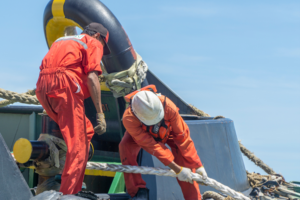Working safely near overhead electric power lines
8 min read[vc_row][vc_column][vc_column_text]Workers who operate horticultural mobile elevating work platforms (H/MEWPs) in orchards, or other horticulture workplaces, are at significant risk of accidental contact with overhead power lines.[/vc_column_text][/vc_column][/vc_row][vc_row][vc_column][vc_single_image image=”7981″ img_size=”full” alignment=”center” css=”.vc_custom_1555516456960{margin-top: 10px !important;}”][/vc_column][/vc_row][vc_row][vc_column width=”2/3″][vc_column_text]
Dangers of working Near Overhead Power Lines
The risk of accidental contact with live overhead power lines by workers operating H/MEWPs is significant in orchards and other horticultural workplaces. There is also a significant risk when working near transmission lines. Transmission lines are high voltage lines which transport electrical power over long distances (from power plants to substations). There have been several incidents where H/MEWPs have come into contact with live power lines resulting in serious injury and death. You must avoid any machinery, people or equipment coming within the ‘safe distances’. As set out in the Electrical Code of Practice for Electrical Safe Distances , this is within 4 m of overhead power lines. For overhead transmission lines, the recommendation is to allow a distance of 6 m.[/vc_column_text][/vc_column][vc_column width=”1/3″ css=”.vc_custom_1542193482799{border-left-width: 4px !important;background-color: #f4f4f4 !important;border-left-color: #c6c6c6 !important;border-left-style: solid !important;}”][xt_news title=”Related Posts” query_type=”custom” custom_query=”size:3|order_by:date|order:DESC|post_type:post|categories:43,68″ excerpt_length=”30″][/vc_column][/vc_row][vc_row][vc_column width=”2/3″][vc_column_text]
Managing The Risk
Before work starts identify all overhead power lines in your work area as part of your risk assessment. You must take steps to eliminate or minimise the risks when working near overhead power lines, so far as is reasonably practicable. Orchard and horticulture workplaces should think about what they plant near overhead power lines that may grow into the safe distances around the power lines in the future.
Staying outside The Safe Distances
At no time should any H/MEWP, person or piece of equipment come within the safe distances. This is in any direction – from under, above or either side. If you do need to work within the safe distance zone near an overhead power line, then you must first consult with the line owner. If you are the line owner then you will need to seek technical advice, for example from the local network owner. You should also consider contracting a line mechanic or utility arborist who is qualified to work near overhead electric powerlines to carry out the work.
Work Procedures
If you are operating an H/MEWP near live overhead power lines, then you need to have controls in place to ensure that any machine, person or equipment does not come within the safe distances of any overhead power lines[/vc_column_text][vc_single_image image=”7976″ img_size=”full” alignment=”center” css=”.vc_custom_1555514212503{margin-top: 10px !important;}”][vc_column_text]
Safety Rules
Always follow these Safety 6 rules to prevent the most common mistakes near power lines[/vc_column_text][/vc_column][vc_column width=”1/3″ css=”.vc_custom_1555515678138{border-left-width: 2px !important;background-color: #ffeaa7 !important;border-left-color: #e2e2e2 !important;border-left-style: solid !important;}”][vc_column_text]KEY POINTS
- Always complete a risk assessment to identify any overhead powerlines in the work area before beginning work.
- In your risk assessment outline how you’re going to ensure that no machinery, people or equipment come within 4 m of any overhead power lines or 6 m of transmission lines. These distances must be observed by persons using H/MEWPs.
- Eliminate any risks arising from working near overhead power lines. If you cannot eliminate a risk then you must put controls in place to minimize it.
- Regularly review your property’s risk plan for working near overhead power lines.
[/vc_column_text][/vc_column][/vc_row][vc_row][vc_column][vc_tta_accordion style=”modern” color=”peacoc” active_section=”1″ collapsible_all=”true”][vc_tta_section title=”1. Work at a safe distance” tab_id=”1555514299685-aee7e0c6-3f16″][vc_column_text]This is the most important rule: Work at a safe distance from all power lines. The Occupational Safety and Health Administration (OSHA) requires that equipment be kept at least 10 feet away from power lines with voltages up to 50kV. For lines with voltages higher than 50kV, the required distance is even greater (see below). When uncertain of a power line’s voltage, stay 20 feet away for voltages up to 350 kV and 50 feet away for voltages greater than 350kV. Cranes and derricks are required to take additional steps before beginning work (see OSHA Standards 29 CFR 1926.1400 effective Nov. 8, 2010). Call FPL at 1-800-375-4375 or your local electric utility to identify the voltage of power lines before you begin working. If you witness a violation of this rule, stay away from the equipment and warn the operator to move away from the power line.
| FPL Power Line Voltages | OSHA Minimum Approach Distance* (OSHA 1926.1408 Table A) |
| 0 to 50kV | 10 feet |
| Over 50kV to 200kV | 15 feet |
| Over 200kV to 350kV | 20 feet |
| Over 350kV to 500kV | 25 feet |
| Over 500kV to 750kV | 35 feet |
*Minimum distance for travel under power lines must comply with OSHA Rules.[/vc_column_text][/vc_tta_section][vc_tta_section title=”2.Stay calm, stay away” tab_id=”1555514484534-4e3a9faf-9471″][vc_column_text]
| When operating a piece of equipment that contacts a power line | You should: |
| If you are not in danger from fire or from being struck by a power line |
|
| If you are in danger and must get off the equipment |
|
| If a fellow worker is in danger |
|
[/vc_column_text][/vc_tta_section][vc_tta_section title=”3.Ladders and lines don’t mix” tab_id=”1555514482767-1e44d170-6360″][vc_column_text]Before you begin working, look up and note the location of power lines. You can be seriously hurt or killed if the object you are holding or standing on contacts a power line.
- Before raising or extending any equipment capable of reaching a power line, check in all directions for power lines.
- Keep a safe distance from any power line, measuring from the end or tip of your own extended reach and including the end or tip of any object you are holding or carrying. Remember to allow even greater distance for safety near higher voltage lines such as transmission lines.
- Even nonmetallic ladders and equipment can conduct electricity.
[/vc_column_text][/vc_tta_section][vc_tta_section title=”4. Call before you dig” tab_id=”1555514481755-22fbf44b-0cde”][vc_column_text]One easy call to Utility Authority starts the process of getting underground utility lines marked for free.
- Utility company locators will mark the approximate location and type of underground utilities with paint and flags.
- To avoid costly repairs and construction delays, be sure to contact all Utilities Authorities
[/vc_column_text][/vc_tta_section][vc_tta_section title=”5.Look up and live” tab_id=”1555514480899-839655ab-7d9b”][vc_column_text]Look up when working around overhead power lines, especially when trees are nearby. Branches can hide power lines from view.
- Look up for power lines when using tools of any kind. Even nonmetallic tools can conduct electricity.
- Cranes and derricks that approach working distance within 20 feet of power lines with operating voltages up to 350 kV, or within 50 feet of power lines with voltages greater than 350 kv, are mandated to take “encroachment prevention measures.” See OSHA Standards 29 CFR 1926.1400.
- Look up for power lines when putting up scaffolding, framing a building, painting, pruning trees or picking fruit.
- Trees can conduct electric current. Before moving a tree under a power line, look up and determine the overhead clearance from the top of the tree. Keep a safe distance away as required by OSHA.
- Look up for power lines when working on top of buildings.
- Before transporting large boats or large objects, identify a safe route that avoids power lines. If you cannot avoid power lines, please call 1-800-375-4375 to coordinate transport and temporary removal* or de-energizing of FPL power lines.
* Charges may apply for temporary removal or relocation of power lines. You may need to coordinate transportation of oversized objects with local authorities.[/vc_column_text][/vc_tta_section][vc_tta_section title=”6.Downed lines can be deadly” tab_id=”1555514479599-7d90d78c-7332″][vc_column_text]Always assume that any downed power line is energized, and stay away.
- Do not touch or attempt to move any power line.
- Call your local electric utility immediately.
- If a fellow worker touches a downed line or is handling equipment that contacts a power line, remember that any rescue attempt places you in danger.
- If you must rescue a person in contact with a power line, never use your hands. Use a dry, nonconductive object to move the person to safety.
[/vc_column_text][/vc_tta_section][/vc_tta_accordion][vc_column_text]Below are some examples of controls you could put in place:
- Where any H/MEWP is operating near an overhead power line, the owner or operator places a warning sign in plain view which states: ‘WARNING, KEEP CLEAR OF POWER LINES’.
- Ensure that H/MEWP operators are competent in the operation of their machines, thoroughly briefed and understand the dangers of working near overhead power lines.
- Ensure that a competent safety observer is present at all times. A competent safety observer can be defined as a person who watches the H/MEWP to identify and warn the operator if they are getting too close to the safe distance zone or about any other hazards.
- Ensure that the safety observer is able to maintain effective communication with the operators and alert operators or any other workers immediately if they, or any piece of machinery or equipment, are about to enter the safe distance zone. This should be the safety observer’s sole task.
- Safety observers should remain clear of the H/MEWP at all times and outside of the safe distance zone.
- To avoid distractions, the competent H/MEWP operators should not use cell phones or any electronic equipment, or wear clothing which could impede their vision or movement while working in the defined area.
- The competent operators working near overhead power lines should obey any instructions given by the safety observer.
[/vc_column_text][vc_single_image image=”7980″ img_size=”full” alignment=”center” css=”.vc_custom_1555516548564{margin-top: 10px !important;}”][/vc_column][/vc_row]



